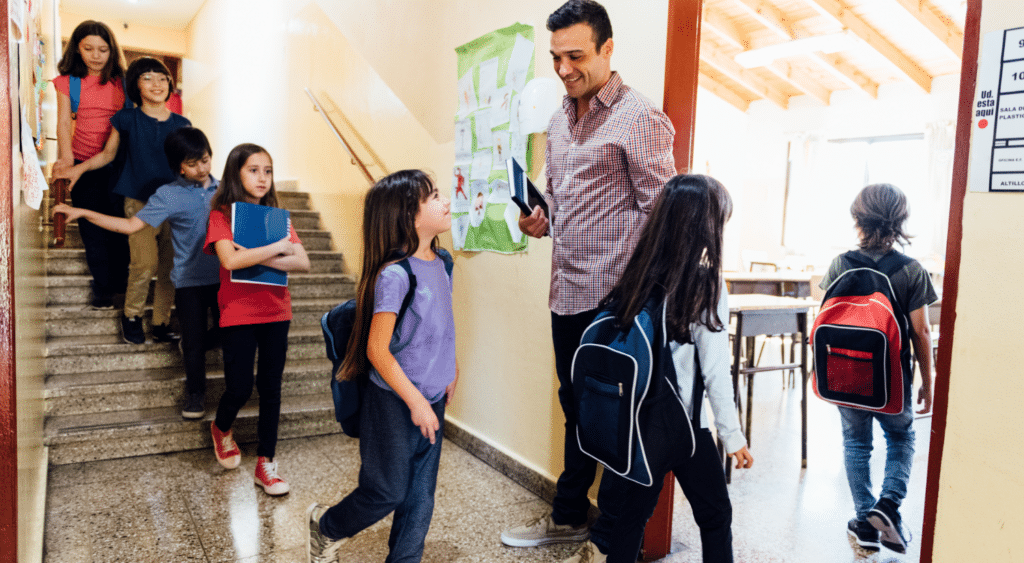Following classroom procedures and routines as a substitute teacher.

Following classroom procedures and routines established by the school and teacher is important as a substitute teacher. It’s all about managing the classroom to ensure the day runs smoothly and safely for everyone.
These common procedural strategies ensure that everything is humming along in sync. As a substitute teacher, you want to be in line with the coordinated dance that makes up a typical school day.
Common classroom procedures and routines:
- Taking attendance
- Lunch and recess procedures
- Cleaning up from projects
- Orderly dismissal at end of day
Ask office for the information you need to succeed.
Since procedures vary widely from school to school and across grade levels, try to gain as much understanding as you can about what the expectations are for your day.
When you arrive at your job, ask the office staff about school-wide procedures. Most commonly, these center around arrival, attendance, and dismissal. If you need clarification, don’t be afraid to ask.
Many schools have some kind of morning announcement either read over a PA system, broadcast onto TVs, or a memo read aloud by the teacher.
Read procedures and routines left by classroom teacher.
Teachers will likely have classroom procedures and routines in addition to school-wide routines.
- Early elementary might have routines for morning meeting that include reviewing the calendar, activities that support social-emotional development, and independence.
- Upper elementary morning meetings might focus more on the schedule of the day, expectations for students, and any changes in routine, such as “no small groups in reading today because a substitute is here.”
- Middle/high school might have routines to start each period by reviewing and/or collecting homework, reminders about upcoming due dates/assignments/projects.
Most teachers will also have a homework routine: put it in the homework basket, leave it in the home-school folder to be collected later, etc.
Speaking of folders: elementary might have home-school folders where teachers and parents send notes and newsletters, homework assignments, permission slips and so on back and forth.
Attendance procedures.
Attendance is an important aspect of school record-keeping for many reasons.
- For safety purposes, teachers and the school to be aware of who is present in the building and where they are.
- The classroom teacher can stay on top of missing work for students who are absent.
If attendance is taken on paper, you will need to know how to turn it in. Is it picked up, or do you need to ensure it arrives at the office?
If it is taken digitally, make sure you have access to the software used to take attendance and don’t forget to hit “submit” when you are finished!
Attendance is typically completed first thing in the morning for elementary school. Middle and high school teachers might take it at the start of each new period. Always check whether there’s a certain time you should have it turned in.
Lunch procedures.
Some schools ask for a daily lunch count so that the cafeteria staff can prepare appropriate amounts of food. You’ll submit the count either physically or electronically by a certain time. You may find it helpful to combine attendance and lunch count to maximize orderliness and save time.
Our substitute teachers add that students often forget to check the menu and will ask you, “What’s for lunch?” Younger students may need additional help understanding their choices. There may be a menu in the classroom or school website, or you can ask for one upon arrival. Be helpful to them!
Dismissal procedures.
An organized dismissal allows everyone to leave safely and get where they’re going on time. Check with the school office about dismissal protocol. Ask what different modes of transportation are available to students and where students need to be for these pickups. Students may ride the bus, walk, or get picked up by parents. Be aware of certain safety rules that the school may have in place.
Also, look at the classroom teacher’s notes about dismissal. They may leave a chart or list that dictates which students use which dismissal method. If you are substitute teaching for a younger grade, you may need to accompany students to a certain location for dismissal Lower elementary procedures may have you dismiss each child directly to a trusted adult.
Pro Tip: Check the teacher notes for info about papers to be sent home, homework reminders, how to tidy up the classroom before students go home, etc. And don’t forget to write a brief wrap-up note to the teacher.
Grow as a substitute teacher with Kelly Education.
Want more great advice from our experts? We’ve got an entire library. Here are a few article selections:
From getting started with the training you need to become a substitute teacher to helping you make a difference in the lives of your students, Kelly Education is here to help you enjoy a career that matters. Fill out our brief interest form and we’ll be in touch to share how you can get started in classrooms in your area.
View Related: Article Workplace culture
You might like
What to wear as a male substitute teacher.
3 minute read
What to wear as a male substitute teacher.
3 minute read
Find your next job
Discover thousands of temporary, full-time, and remote jobs for beginning and experienced job seekers.



